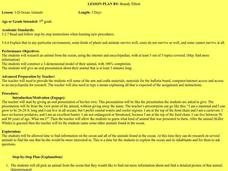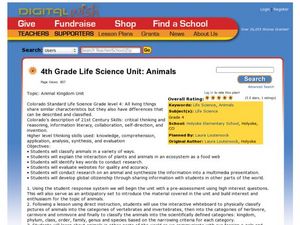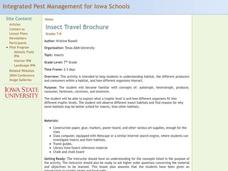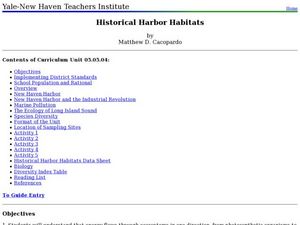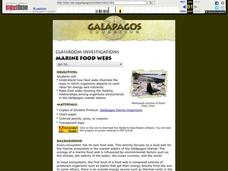Curated OER
Food Web Mobile
Students explain the main concepts of food webs and food chains. They
describe the role of animals, plants, and other organisms in cycling energy and matter through a food web by creating mobiles. Lesson contains adaptations for all levels.
Aiken County Public Schools
Claymation in the Classroom
Learners design an appropriate and usable storyboard and then create a claymation video. They take digital photographs frame by frame, then assemble the stop-motion movie using video software.
Curated OER
3-D Ocean Animals
Fifth graders research an animal from the ocean, using the internet and encyclopedias, with at least 5 out of 5 topics covered. They also construct a 3-dimensional model of their animal and give an oral presentation about their animal...
Curated OER
4th Grade Life Science Unit: Animals
Fourth graders classify animals. In this animal kingdom lesson, 4th graders research animal habitats and behaviors. Students connect to a zoologist via SKYPE and learn about animal classification. Students blog about preserving animal...
Curated OER
Insect Travel Brochure
Students explore the concept of insects and their habitats. For this insect habitat lesson, students create travel brochures for particular insects. Students must include habitat, producers, and consumers with in the vacation spot.
Curated OER
Rainforest Food Chain
Students investigate a rainforest food chain. In this ecology instructional activity, students are shown pictures of plants and list what animals might eat the plants. Students continue to think of what other animals might eat those...
Curated OER
Ecological Impact of River Dams
Students investigate their environment by completing an in-class experiment. In this ecological lesson, students define the roles of dams and how electricity is created by them. Students utilize plastic jugs, sand and tap water to...
Curated OER
Historical Harbor Habitats
Tenth graders create food web displays in the classroom. In this ecology lesson, 10th graders identify the different pollutants in the environment and their effect on organisms. They collect samples of sediments from the harbor and...
Curated OER
Animal Brochures
Fourth graders work in pairs to research an animal. They fill in an animal data form in order to become experts about the animal they choose. They use the listed criteria to design a six sided brochure that includes graphics of the...
Curated OER
Marine Food Webs
Learners examine how food webs illustrate the ways in which organisms depend on each other for energy and nutrients, and make food webs showing the feeding relationships among organisms encountered in the Gal??pagos coastal waters.
Curated OER
Energy Flow in Ecosystems
Students, in groups, create a slide show about the ecosystem and answer critical thinking questions based on their research.
Curated OER
Secrets of the Ocean Realm - Survival in the Sea
Middle schoolers determine the sequential links in a marine food chain and identify the roles that various organisms play in this chain. Students develop charts as visual aids for illustrating marine food chains.
Curated OER
Which One Matters?
Young scholars study the balance necessary to maintain ecosystems and how changing that balance can impact the ecosystem. They identify and discuss the need for balance in any ecosystem and discuss how greenhouse gases impact ecosystems.
Curated OER
Dinosaurs
Students explore dinosaurs. In this science lesson, students discuss the characteristics of various dinosaurs and color masks and pictures of the dinosaur groups they have chosen.
Curated OER
Constructing A Food Web
Pupils identify and explain the relationships within a food web. They use index cards to glue pictures of producers and consumers. On the back of the card, students name the organism, list the type of biome in which it is found.
Curated OER
Who Is Eating Whom?
Students discuss the food chain and identify if various organisms are producers or consumers. They draw ten types of organisms and construct a food web of these organisms, labelling each as a producer or consumer.
Curated OER
Insect Travel Brochure
Seventh graders study producers and consumers in habitats. They examine the trophic levels and how different organisms interact with a focus on insects. They create a travel brochure for an insect to visit a habitat which they create.
Curated OER
Bats
Pupils model how the bones in a bat wing are organized. They develop questions about bat body parts based on photographs. They hypothesize how bats locate their food.
Curated OER
Dinosaur Daze
Learners review, create, and inquire about dinosaurs, the fossilization process, and paleontology by successfully completing each of six classroom stations.
Curated OER
Forest Food Web
Students explore the elements of a forest ecosystem. They examine the elements needed to form a forest food web. Students construct and describe food webs that include nonliving elements of the ecosystem.
Curated OER
My Biotic Creation
Eighth graders explore different ecosystems. In this ecosystem survival lesson conditions lesson students create their own fictional creature.
Curated OER
The Basics: Life Science
Young scholars develop an understanding of the different fields of study that are encompassed by the term, life science. They view and discuss a video on the topic. In small groups they focus on on of the examples shown in the video to...
Curated OER
Let's Create an Ecosystem
Seventh graders discover how an ecosystem works by creating one in class. In this Earth science lesson, 7th graders study vocabulary terms associated with ecosystem and read environment handouts. Students create an observatory...
Curated OER
Basic Knowledge of Big Cats
First graders create a KWL chart on big cats. In this animal science lesson, 1st graders brainstorm what they already know about big cats and research big cats using various suggested websites. Students fill in the last column of the KWL...
Other popular searches
- Carnivore +Herbivore(teeth)
- Herbivores Carnivores
- Carnivore Herbivore
- Omnivore Herbivore Carnivore
- Producers and Carnivores
- Herbivores and Carnivores
- Herbivore and Carnivore
- Herbivores. Carnivores
- Herbivore Carnivore Teeth
- Carnivores Omnivore Herbivores




